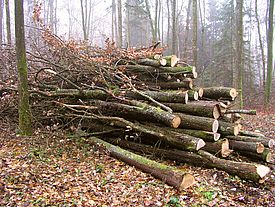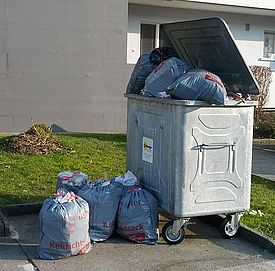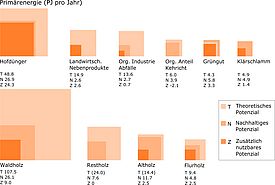29.08.2017 | News
Biomass has great potential in Switzerland for future heat and electricity generation and fuel production. This potential is far from being exhausted. Energy derived from wood, farm manure and waste can be stored and used whenever there is no wind or sunshine. For the first time, researchers at the Swiss Federal Institute for Forest, Snow and Landscape Research (WSL) have completed a comprehensive assessment of the potential of biomass energy in Switzerland.
By deciding to go forward with the energy transition, Switzerland is planning to lower the quantity of electricity generated from nuclear and fossil fuels and compensate it by using renewable sources such as biomass. Wood is the most extensively available type of biomass in Switzerland, whereby most timber of better quality is used in construction and in interior design. Some wood is also exploited for energy, especially for generating heat. However, non-woody biomass, such as farmyard manure, organic waste, sewage sludge and by-products of agricultural crops also contain valuable energy.
Up to now, it was not known how much of each biomass type is available in Switzerland, which regions generate more or less biomass, or how much of it can be used to generate energy on a sustainable basis. Finding this out was a prime objective of a WSL research project conducted by the Swiss Competence Centre for Bioenergy Research (SCCER BIOSWEET).
Considerable, but regionally variable potential
The research results showed that at most 209 petajoules (PJ) of primary energy can be extracted from biomass every year in Switzerland, mainly from forest wood and farm manure. According to the Swiss Federal Office of Energy (SFOE), this theoretically available quantity corresponds to the energy content of 4.8 million tonnes of crude oil or about 19% of Switzerland's total energy consumption. Most biomass is available in the cantons of Bern, Vaud and Zurich.
However, only 97 PJ of these 209 PJ are sustainable, i.e. environmentally compatible and cost-effective, because some types of biomass, such as forest wood in inaccessible mountain valleys or on road and railway embankments can only be procured at high cost. Conservation areas also limit the amount of available wood. Other types of biomass, such as farm manure, cannot currently be viably converted into energy, primarily because many farms only produce it in very small quantities. This is where SCCER BIOSWEET's technological research is taking up the challenge to develop and implement efficient, environmentally friendly conversion processes.
Manure and forest wood offer the greatest energy potential
Of relevance here are the types of biomass with sustainable potential, namely forest wood and manure, which account for 26 PJ and 27 PJ respectively of the total potential of 97 PJ. This amout is complemented by other biomass types (waste wood, organic waste, biogenic household waste and wood from landscape maintenance, industrial bio-waste, sewage sludge and residual wood) contributing a total of 37 PJ and agricultural crop residues and farmland wood contributing well over 7 PJ.
The amount of biomass already used today totals about 53 PJ per annum. The results obtained suggest that a further 44 PJ derived from biomass could be sustainably exploited for energy generation, mainly from farm manure (contributing another 24 PJ), but also from already intensively used forest energy wood (9 PJ). On the other hand, less organic waste will be available in the future because it is increasingly being collected as cuttings or compost.
Twice as much energy from biomass
Calculated across all biomass categories, it would be possible to exploit roughly twice as much biomass in Switzerland as is currently being used mainly to generate heat and electricity. Even though the amount of energy in question would 'only' correspond to roughly 9% of Switzerland's gross energy consumption, energy can be extracted from biomass in a far more controlled manner than from wind and sunlight. Biomass could thus compensate for the fluctuation of other renewable energies and help to avoid energy bottlenecks.
This makes biomass a valuable raw material that is already available in Switzerland and can be efficiently converted into energy. However, today exploiting this resource is still often too expensive. Nevertheless, it can be assumed that greater exploitation of energy from biomass will provide incentives to develop more efficient and cost-effective processes.
Consequently, the Competence Centre BIOSWEET's vision of seeing biomass contribute 100 PJ per annum to Switzerland's energy supply by 2050 appears entirely realistic with respect to the quantity of resources available in the country. This makes biomass an important pillar and major hope in the context of the energy transition.
Contact ¶
Links and documents ¶
Copyright ¶
WSL and SLF provide image and sound material free of charge for use in the context of press contributions in connection with this media release. The transfer of this material to image, sound and/or video databases and the sale of the material by third parties are not permitted.




